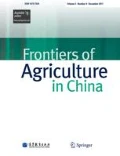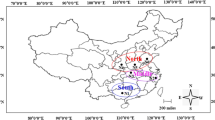Abstract
To determine the pathogens of cucumber downy mildew and cucumber powdery mildew by molecular marker, we amplified and sequenced the rDNA-ITS region of the pathogens of cucumber downy mildew and cucumber powdery mildew collected from the Shanghai region. The intra-/interspecific sequence difference was analyzed by rDNA-ITS sequence. The results show that the length of rDNA-ITS1 and rDNA-ITS2 of cucumber downy mildew’s pathogen was 141 bp and 406 bp, respectively, with GC contents of 41.13% in ITS1 and 46.8% (Minhang and Jinshan District, sm1 and sm2) or 46.55% (Pudong District, sm3) in ITS2. The rDNA-ITS sequence was intraspecific conservation. The interspecific difference was related with their kin relationship. The pathogen of cucumber downy mildew was identified as Pseudoperonospora cubensis by molecular marker. The length of rDNA-ITS1 and rDNA-ITS2 of cucumber powdery mildew’s pathogen was 136 bp and 89 bp, respectively, with GC contents being 59.56% and 66.29%, and rDNA-ITS sequence being highly conservative in this study that was the same as Sphaerotheca cucurbitae. But the sequence difference between the strains in the Shanghai region in this study with S. fuliginea was 4.5%, which was identified by morphology. It is suggested that the pathogen of cucumber powdery mildew should be further clarified and determined.
Similar content being viewed by others
References
Chen G Q, Han S J, Lai Y Q, Yu Y N, Zheng R Y, Zhao Z Y (1987). Flora Fungorum Sinicorum, Vol. 1, Erysiphales. Beijing: Science Press, 78, 316 (in Chinese)
Hirata T, Cunnington J H, Paksiri U, Limkaisang S, Shishkoff N, Grigaliunaite B, Sato Y, Takamatsu S (2000). Evolutionary analysis of subsection Magnicellulatae of Podosphaera section Sphaerotheca (Erysiphales) based on the rDNA ITS sequences with special reference to host plants. Canadian Journal of Botany, 78: 1521–1530
Kiss L, Cook R T A, Saenz G S, Cunnington J H, Takamatsu S, Pascoe I, Bardin M, Nicot P C, Sato Y, Rossman A Y (2001). Identification of two powdery mildew fungi, Oidium neolycopersici sp. nov. and O. lycopersici, infecting tomato in different parts of the world. Mycological Research, 105(6): 684–697
Motoaki K, Takashi T (1995). Phylogeny of Alternaria fungi known to produce host-specific toxins on the basis of variation in internal transcribed spacers of ribosomal DNA. Current Genetics, 28: 491–498
Qiu W F (1979). Agricultural Plant Pathology. Beijing: Agricultural Press, 465 (in Chinese)
Takamatsu S, Hirata T, Sato Y (1998). Phylogenetic analysis and predicted secondary structures of the rDNA internal transcribed spacers of the powdery mildew fungi (Erysiphaceae). Mycoscience, 39: 441–453
Takamatsu S, Hirata T, Sato Y (2000). A parasitic transition from trees to herbs occurred at least twice in tribe Cystotheceae (Erysiphaceae): evidence from nuclear ribosomal DNA. Mycological Research, 104: 1304–1311
Tetsuya H, Susumu T (1996). Nucleotide sequence diversity of rDNA internal transcribed spacers extracted from conidia and cleistothecia of several powdery mildew fungi. Mycoscience, 37: 283–288
Voglmayr H (2003). Phylogenetic relationships of Peronospora and related genera based on nuclear ribosomal ITS sequences. Mycological Research, 107(10): 1132–1142
Wei J C (1979). Fungi Identification Notebook. Shanghai: Shanghai Scientific & Technical Publishers, 49 (in Chinese)
White T J, Bruns T, Lee S, Taylor J (1990). Amplification and direct sequencing of fungal ribosomal RNA genes for phylogenetics. California: Academic Press, 315–321
Yi J P, Tao T D, Pan L W, Shen Y F, Yin L P, Zheng J Z (2002). Direct detection of Tilletia indica teliospores by nest PCR. Plant Quarantine, 16(4): 197–200 (in Chinese)
Yu Z D, Zhang X Y, Cao Z M (2000). A review of the studies on ribosomal DNA internal transcribed spacer of fungi. Journal of Northwest Forestry University, 15(2): 107–112 (in Chinese)
Author information
Authors and Affiliations
Corresponding author
Additional information
__________
Translated from Journal of Northwest A & F University (Nat. Sci. Ed.), 2007, 35(10): 155–158 [译自: 西北农林科技大学学报(自然科学版)]
About this article
Cite this article
Wang, N., Ma, Y., Yang, C. et al. rDNA-ITS sequence analysis of pathogens of cucumber downy mildew and cucumber powdery mildew. Front. Agric. China 2, 317–320 (2008). https://doi.org/10.1007/s11703-008-0061-z
Published:
Issue Date:
DOI: https://doi.org/10.1007/s11703-008-0061-z




